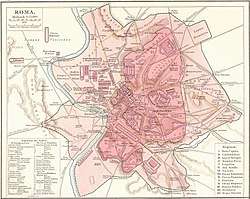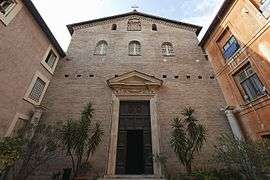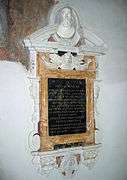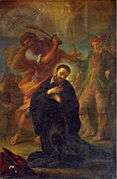Santa Prassede
The Basilica of Saint Praxedes (Latin: Basilica Sanctae Praxedis, Italian: Basilica di Santa Prassede all’Esquillino), commonly known in Italian as Santa Prassede, is an ancient titular church and minor basilica located near the papal basilica of Saint Mary Major, on Via di Santa Prassede, 9/a in rione Monti of Rome, Italy. The current Cardinal Priest of Titulus Sancta Praxedis is Paul Poupard.
| Basilica of Saint Praxedes Basilica di Santa Prassede all’Esquilino (in Italian) Basilica Sanctae Praxedis (in Latin) | |
|---|---|
.jpg) Ceiling of the San Zeno chapel. | |
| Religion | |
| Affiliation | Roman Catholic |
| Rite | Latin Rite |
| Ecclesiastical or organizational status | Minor basilica |
| Leadership | Paul Poupard |
| Patron | Saint Praxedes |
| Location | |
| Location | Rome, Italy |
 Shown within Rome  Santa Prassede (Rome) | |
| Geographic coordinates | 41°53′46″N 12°29′55″E |
| Architecture | |
| Type | Church |
| Style | Byzantine |
| Groundbreaking | 780 |
| Completed | 822 |
| Specifications | |
| Direction of façade | SSE |
| Length | 45 metres (148 ft) |
| Width | 30 metres (98 ft) |
| Width (nave) | 17 metres (56 ft) |
| Website | |
| Chiesa Rettoria Santa Prassede | |
History
The church incorporates mosaic decoration that marks it among the oldest churches in Rome. A church near this site was present since the fifth century, but the church in its current place and general layout was commissioned by Pope Hadrian I around the year 780 to house the relics (bones) of Saint Praxedes (Italian: S. Prassede) and Saint Pudentiana (Italian: S. Pudenziana), the daughters of Saint Pudens, traditionally St. Peter's first Christian convert in Rome. The church was built atop of the remains of a 4th-century ancient Roman Thermae, privately owned by the family of Pudentiana, and called Terme di Novato.[1] The two female saints were murdered for providing Christian burial for early martyrs in defiance of Roman law. The basilica was enlarged and decorated by Pope Paschal I in c. 822.
Pope Paschal, who reigned 817–824, was at the forefront of the Carolingian Renaissance started and advocated by the emperor Charlemagne. They desired to get back to the foundations of Christianity theologically and artistically. Paschal, thus, began two, linked, ambitious programs: the recovery of martyrs' bones from the catacombs of Rome and an almost unprecedented church building campaign. Paschal dug up numerous skeletons and transplanted them to this church. The Titulus S. Praxedis was established by Pope Evaristus, around 112.
The inscriptions found in Santa Prassede, a valuable source illustrating the history of the church, have been collected and published by Vincenzo Forcella.[2]
The church contains the oratory of San Zenone.
The church provided the inspiration for Robert Browning's poem "The Bishop Orders His Tomb at Saint Praxed's Church."
Interior
The main altarpiece is a canvas of St Praxedes Gathering the Blood of the Martyrs (c. 1730–35) by Domenico Muratori.
Mosaic
The most famous element of the church is the mosaic decorative program. Paschal hired a team of professional mosaicists to complete the work in the apse, the apsidal arch, and the triumphal arch. In the apse, Jesus is in the center, flanked by Sts. Peter and Paul who present Prassede and Pudenziana to God. On the far left is Paschal, with the square halo of the living, presenting a model of the church as an offering to Jesus. Below runs an inscription of Paschal's, hoping that this offering will be sufficient to secure his place in heaven.
On the apsidal arch are twelve men on each side, holding wreaths of victory, welcoming the souls into heaven. Above them are symbols of the four Gospel writers: Mark, the lion; Matthew, the man; Luke, the bull; and John, the eagle, as they surround a lamb on a throne, a symbol of Christ's eventual return to Earth.
| External video | |
|---|---|
Those mosaics, as well as those in the Chapel of Saint Zeno, a funerary chapel which Pope Paschal built for his mother, Theodora,[3] are the best-known aspects of the church. Also noteworthy are ancient frescoes. Ascending a spiral staircase, one enters a small room, covered in scaffolding; on the wall is a fresco cycle, dating most likely from the 8th century. The frescoes probably depict the life-cycle of the name saint of the church, Praxedes.
Pillar of the Flogging
Santa Prassede also houses an alleged segment of the pillar or column upon which Jesus was flogged and tortured before his crucifixion in Jerusalem. The relic is alleged to have been discovered in the early 4th century by Saint Helena (mother of the Roman Emperor Constantine I) who at the age of eighty undertook a pilgrimage to the Holy Land, where she founded churches for Christian worship and rescued relics associated with the crucifixion of Jesus on Calvary. In 1223, Cardinal Giovanni Colonna, as emisarry to the holy land in 1223 was said to have obtained this artifact and brought it to Rome.
Among these legendary relics retrieved by Helena, which included pieces of the True Cross (now venerated at St. Peter's Basilica[4] with fragments in Santa Croce in Gerusalemme, also in Rome) and wood from the Jesus' crib enshrined at S. Maria Maggiore. These items, including the Santa Prassede pillar, lack indisputable authenticity, due to absence of forensic evidence and the abundance of other objects claimed during the medieval period to have the same historic function.
Titulus
Among the known titular clerics of the Basilica are Lambertus Scannabecchi (later Pope Honorius II, circa 1099), Ubaldo Allucingoli (later Pope Lucius III, 1141), Alain de Coëtivy (1448), Giovanni Maria Ciocchi del Monte (later Pope Julius III, 1542–3), Saint Charles Borromeo (1538–84), and Rafael Merry del Val (1903–30).[5]
Gallery
- Plan.
 Internal façade
Internal façade- Entrance
_-_Interior.jpg) Interior
Interior- Triumphal arch mosaic
.jpg) Ceiling of the Chapel of Saint Zeno
Ceiling of the Chapel of Saint Zeno- Crypt
 Pope Paschal I presenting a model of the Basilica to Christ. His square halo indicates that he was alive when the mosaic was made.
Pope Paschal I presenting a model of the Basilica to Christ. His square halo indicates that he was alive when the mosaic was made. Funerary monument of Bishop Giovanni Battista Santoni († 1592); bust by Giovanni Lorenzo Bernini, circa 1612.
Funerary monument of Bishop Giovanni Battista Santoni († 1592); bust by Giovanni Lorenzo Bernini, circa 1612. "San Tesauro Beccaria" by Domenico Pestrini
"San Tesauro Beccaria" by Domenico Pestrini Tomb of Giovanni Carbone, 14th century
Tomb of Giovanni Carbone, 14th century
References
- Accurata, E Succinta Descrizione Topografica, E Istorica Di Roma, Volume 1, by Ridolfino Venturini, published by Carlo Barbellieni, Rome (1768); page 43.
- V. Forcella, Inscrizioni delle chese e d' altre edifici di Roma, dal secolo XI fino al secolo XVI Volume II (Roma: Fratelli Bencini, 1873), pp. 489–524.
- "The Chapel of Saint Zeno at Santa Prassede: mosaic revival and survival". ArtTrav. Retrieved 4 March 2014.
- Basilica of St. Peter,
- S. Prassede (Cardinal Titular Church)
Bibliography
- B. M. Apollonj Ghetti, Santa Prassede (Roma: Edizioni Roma, 1961).
- Gillian Vallance Mackie, The Iconographic Programme of the Zeno Chapel at Santa Prassede, Rome [M.A. University of Victoria (B.C., Canada) 1985].
- Marchita B. Mauck, “The Mosaic of the Triumphal Arch of Santa Prassede: A Liturgical Interpretation.” Speculum 62–64 (1987), pp. 813–828.
- Rotraut Wisskirchen, Mosaikprogramm von Santa Prassede in Rom (Münster: Aschendorff, 1990).
- Anna Maria Affanni, La chiesa di Santa Prassede: la storia, il rilievo, il restauro (Viterbo: BetaGamma, [2006]) [Testimonianze di restauri, 5].
- Mary M. Schaefer, Women in Pastoral Office: The Story of Santa Prassede, Rome (New York, NY: Oxford University Press, 2013).
- Maurizio Caperna, La basilica di Santa Prassede: il significato della vicenda architettonica (Roma: Edizioni Quasar, 2013).
- Benedictine Monks of Vallombroso, The Basilica of Saint Praxedes, in memory of their eighth century of presence at Saint Praxedes: 1198–1998 (Genova, Italia: B.N. Marconi, Fourth Edition, January 2014).
External links
| Wikimedia Commons has media related to Basilica di Santa Prassede (Roma). |
- Kunsthistorie.com, photogallery.
- Santa Prassede Mosaics
- High-resolution 360° Panoramas and Images of Santa Prassede | Art Atlas
